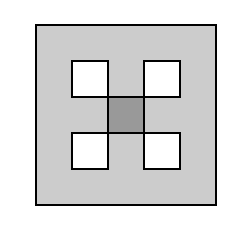
A fundamental property of top sets is that a top set of a tight immersion is itself a tight immersion [K4]. A surprising result is that a top set need not be an embedding, as shown below.

In general, the interesting top sets are those containing the top cycles. For smooth surfaces, distinct top sets must be disjoint, but for polyhedral surfaces, different top sets can share points or even edges, so the top cycles need not be distinct.
A top cycle has the following important properties:
Another way to see this is to consider the supporting plane for the top cycle, and imagine pushing the plane down (through the surface). As it moves, it intersects the surface in two curves, one on each side of the top cycle. These curves trace out a neighborhood that is an orientable strip (since it has two boundary curves). This holds for both smooth and polyhedral surfaces.
The lower bound is easy to see (using the decomposition of the surface
into M+ and M- regions
![[More]](pix/Link.gif) ):
if a tight immersion of a connected surface has no top cycles, then it
is necessarily a sphere, since in this case the image of the M+
region is all of the convex envelope (and there is no M-
region). So a tight immersion of any surface other than the sphere
must have at least one top cycle. On the other hand, it can't have
just one, since such a top cycle would bound a region (namely, the
region M+), so there must be at least two top cycles.
):
if a tight immersion of a connected surface has no top cycles, then it
is necessarily a sphere, since in this case the image of the M+
region is all of the convex envelope (and there is no M-
region). So a tight immersion of any surface other than the sphere
must have at least one top cycle. On the other hand, it can't have
just one, since such a top cycle would bound a region (namely, the
region M+), so there must be at least two top cycles.
The upper bound comes from the fact that the Euler characteristic is tied to the genus of the surface, and the genus limits the number of tubes that can be used to attach the interior M- region to the outer M+ region along the top cycles.
![[Right]](pix/Right.gif) Tightness and polar height functions
Tightness and polar height functions
![[Left]](pix/Left.gif) Tightness and the convex hull
Tightness and the convex hull
![[Up]](pix/Up.gif) Tightness and its consequences
Tightness and its consequences
7/22/94 dpvc@geom.umn.edu --
The Geometry Center